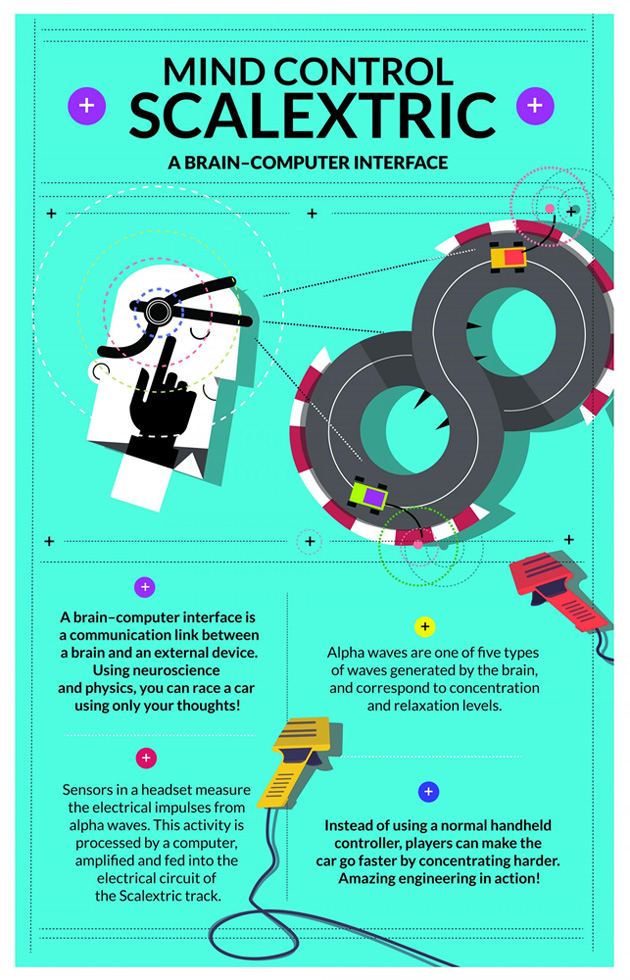Toys are an inseparable part of our childhood years, no matter where on the Earth we live or how poor or rich we are. The difference comes in the materials used to make the toys, and whether they are especially designed to be used as a toy with an educational purpose, or an ordinary object turned into a toy through the imagination of a child. Many of us remember folding an ordinary piece of paper into an intricate airplane and watching with delight as it flies through the sky. The toy market however, has advanced apace, driven by the technological revolution in our everyday life. Now, electronics, sensing technologies, robotics, artificial intelligence and green energy usage are all playing an important role in the design of the toys of the future.
Brain-Computer Interfaces
Scientists have been fascinated for nearly a century now, by the idea of having actions performed through brain signals rather than muscles. But what exactly is a brain-computer interface, or BCI? Our central nervous system (CNS) has the ability to respond to events of both the outside world and our own body, by producing neuromuscular or hormonal outputs which serve the needs of the organism. The brain-computer interface represents an additional artificial output for the CNS, with the role of replacing, restoring, enhancing, supplementing or improving the natural CNS output. In this scope, the BCI is aiming to translate the CNS activity into the correct output. CNS activity consists of a multitude of electrophysiological, neurochemical and metabolic phenomena, including synaptic potentials, neuronal action and oxygen consumption, for example. These can be quantified by monitoring electric or magnetic fields and other parameters, through special sensing technologies either at surface level, on the scalp or on the brain, or in an invasive fashion within the brain.
Mind-Controlled Toys
Researchers at the Warwick School of Engineering are trying to connect the human mind with electronic devices embedded in a child's toy, by developing the SCALEXTRIC brain-computer interface. Sensors in the headset a child is wearing while playing will receive ‘brain waves’ and then feed these brain waves into electrical circuits controlling the toy. The electromagnetic pulses that will be produced will depend on the frequencies of the waves. As a result, the SCALEXTRIC set will be activated by the child's concentration alone, rather than using a remote control.

Infographic on mind-controlled Scalextric. Credit: University of Warwick
Professor Christopher James, the Director of the Warwick Engineering in Biomedicine Laboratory, sees a bright future and demanding market, which is not limited to toy design and production. When talking about the future potential of the SCALEXTRIC technology:
“Whilst brain-computer interfaces already exist – there are already a few gaming headsets on the market – their functionality has been quite limited. New research is making the headsets now read cleaner and stronger signals than ever before – this means stronger links to the toy, game or action thus making it a very immersive experience. The exciting bit is what comes next –how long before we start unlocking the front door or answering the phone through brain-computer interfaces?”
The Other Side of the Coin
The term ‘interface’ is loaded with a double meaning, which means that the very same device can act both for input and output. The question is, can such a toy in the future play also the role of feeding into the brain? If so, what would be the scope? Since human minds can be connected with electronic devices, this may be creative or potentially dangerous. Thinking more pessimistically, is it possible that such research would actually restrict the freedom of individuals? One excessive case of this magnitude is the induction of potential addiction of a child to the specific toy. We would say we all need to be careful when even talking about such toys-devices, which imply a gaming activity for the child, but needs a serious approach with respect to the actual relationship between the child and the toy. We wouldn't like to have to question who is controlling, and who is being controlled.
“When two things occur successively we call them cause and effect if we believe one event made the other one happen. If we think one event is the response to the other, we call it a reaction. If we feel that the two incidents are not related, we call it a mere coincidence. If we think someone deserved what happened, we call it retribution or reward, depending on whether the event was negative or positive for the recipient. If we cannot find a reason for the two events' occurring simultaneously or in close proximity, we call it an accident. Therefore, how we explain coincidences depends on how we see the world. Is everything connected, so that events create resonances like ripples across a net? Or do things merely co-occur and we give meaning to these co-occurrences based on our belief system? Lieh-tzu's answer: It's all in how you think.”
― Liezi, Lieh-tzu: A Taoist Guide to Practical Living
Top image: Brain Computer Interface / g-tech medical engineering (CC BY-NC-ND 2.0)
References:
- Toy History: https://en.wikipedia.org/wiki/Toy#History
- SCALEXTRIC, A brain-computer interface: http://www2.warwick.ac.uk/newsandevents/news/mind-controlled_toys_the/
- Wolpaw, Jonathan, and Elizabeth Winter Wolpaw, eds. Brain-computer interfaces: principles and practice. OUP USA, 2012.







No comment